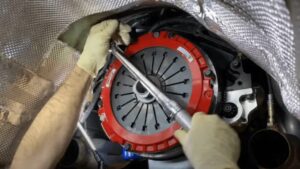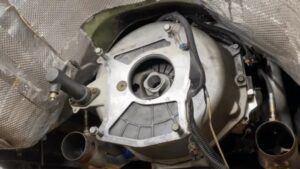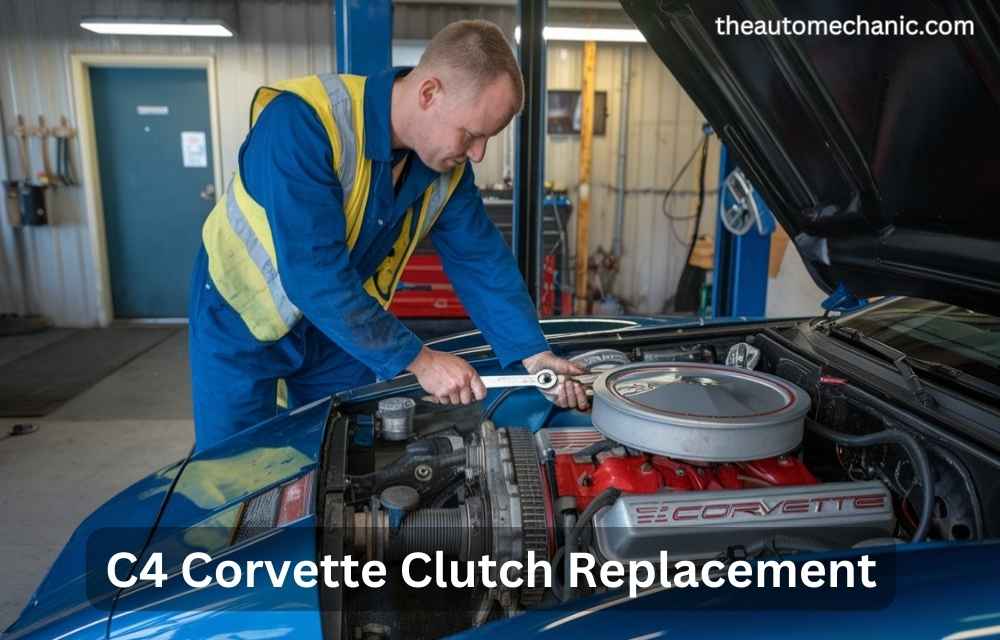This comprehensive guide will delve into the intricate world of C4 Corvette Clutch Replacement, demystifying the process and shedding light on the why, when, and how. Whether experiencing telltale signs like slipping gears or simply aiming to ensure your ride’s longevity, we’ve got you covered.
Get ready to reinvigorate your driving experience, enhance your Corvette’s capabilities, and embark on a seamless transition toward a smoother, more exhilarating ride.
When Do You Need The C4 Corvette Clutch Replacement?
Knowing when to replace the clutch in your C4 Corvette is essential to ensure smooth and reliable performance. Look out for these five warning signs of a worn clutch that indicate the need for immediate attention and potential replacement:
Heavy Grinding Noise
A grinding noise when depressing the clutch pedal could indicate worn bearings. Ignoring this noise may lead to more significant issues. Pay attention to any burning or rotten smell from the engine, as constant “riding the clutch” driving can cause premature clutch failure due to inadequate cooling.
Problems With Slipping
Clutch slipping occurs when the engine RPM increases, but the vehicle’s speed doesn’t change as expected. This indicates that the clutch is not fully engaging or disengaging. Driving uphill, overtaking, or carrying heavy loads can exacerbate the issue. To test for slipping, engage the clutch in third gear immediately after starting the car. If the engine speed increases without a corresponding change in speed, it’s time to replace the clutch.
Frequent Shifting Troubles
Difficulty shifting gears, even with a fully depressed clutch, suggests a worn clutch. If you experience resistance, trembling gear shifts, or struggle to engage gears, it’s a sign that your clutch may be nearing the end of its life. This could also be related to a malfunctioning clutch fork or cylinder, so a thorough inspection is recommended.
Soft Clutch Issues
A spongy or overly soft clutch pedal is one of the early signs of clutch wear. If you notice that the clutch pedal feels mushy and requires excessive pressure to engage gears, it’s time to consider a replacement. Shuddering of the clutch pedal, especially at low speeds, indicates a worn clutch plate contaminated with oil or debris. In either case, seek professional repair promptly to avoid further damage.
Cylinder Defects
While the clutch plate is a common culprit, other components like cylinders, bearings, or the fork can also contribute to clutch problems. A direct linkage clutch system might benefit from a clutch cable linkage replacement. Inspect the enslaver and enslaved person cylinders in a hydraulic clutch system for leaks or other defects, as they might need replacement to ensure proper clutch function.
How To Replace The Clutch In Your C4 Corvette Clutch?
Replacing the clutch in your C4 Corvette requires careful steps to ensure a successful and efficient process. Follow these guidelines for a smooth clutch replacement:

Step-1: Diagnose the Issue
Before beginning the replacement, identify the specific problem with your clutch. Determine whether it’s making grinding noises during gear shifts or exhibiting signs of slipping. This will help you understand the extent of the issue and whether a complete replacement is necessary.
Step 2: Disconnect the Slave Cylinder
If you’re not planning to move the slave cylinder, disconnect its hydraulic supply from the bell housing. Remove the clevis pin that holds the slave rod to the clutch fork. Clamp the flexi-hose and remove the feed pipe’s nut to prevent the master cylinder from draining.
Step 3: Remove the Gearbox
To access the clutch components, you’ll need to remove the gearbox. This involves unbolting the starting motor, propeller, speedometer drive, and cross-member or chassis mounts. Be cautious when lifting and moving the gearbox, as many bell housings are lightweight aluminum and can be easily damaged.
Step 4: Inspect Every Assembly
Thoroughly inspect all clutch components for wear and damage. Check the clutch plate for smoothness and grooves, ensuring the springs are secure and the pressure plate is crack-free. Examine the flywheel face, clutch fork, and roller release bearing for any signs of wear or damage.
Step 5: Clutch and Plate Installation
Install the clutch plate with the correct orientation, typically with the longer side of the spigot facing the pressure plate. Align the plate using an alignment tool and hand-torque the bolts to avoid damaging the threads. Follow any balance indications on the flywheel and pressure plate.
Step 6: Bearing Replacement
If necessary, replace the release bearing. Carbon release bearings and roller release bearings have different characteristics. Carbon bearings have low-friction surfaces, while roller bearings allow for free spinning. Always replace worn spring clips and never reuse old ones.
Step 7: Final Inspection and Assembly
Inspect the phosphor-bronze spigot bearing on the crankshaft for wear. Replace if needed using oil and a proper tool. Screw in the replacement slowly and securely before reassembling the gearbox.
Step 8: Hydraulic Bleeding and Adjustment
Reconnect the slave cylinder and bleed the hydraulic system. Adjust the free play in the slave rod or master cylinder to prevent the release bearing from touching the pressure plate. Tighten all locknuts. Take the car for a test drive to ensure proper clutch engagement and functionality.
Step 9: Check for Leaks and Free Play
After driving, check for leaks and free play again when the clutch is hot. Ensure that the clutch is operating smoothly and that there are no signs of hydraulic fluid leaks.
How To Change The Master And Slaved Cylinders In A C4 Clutch?
Changing the master and slave cylinders in a C4 hydraulic clutch involves several steps to ensure a smooth and effective process. Follow these guidelines for a successful replacement:
Battery Removal
Before starting any work, remove the battery from your C4. This will provide easier access to the clutch master cylinder and the necessary components.
Remove the Slave Cylinder
To begin, remove the clutch slave cylinder. For better access, elevate your Corvette on ramps or blocks. Unscrew the two bolts holding the cylinder in place. After removing the slave cylinder, the fluid line fitting on the master cylinder becomes more accessible.
Master Cylinder Removal
Disconnect the clutch master cylinder push rod, secured in the pedal assembly by a clip. Carefully detach the push rod from the pedal. Depending on your preference, you can either access the master cylinder from beneath the dashboard or by climbing up the side of the car. Consider removing the seat for easier entry. With the Targa top down, open the driver’s side door and reach beneath for access.
Prepare the New Slave Cylinder and Brake Fluid
Add new DOT3 brake fluid to the slave cylinder. Ensure you avoid spilling brake fluid, as it is slippery and harmful. The slave cylinder can be filled on a workbench or under the vehicle, but the aperture must remain slanted upwards. Once the slave cylinder is filled, proceed to fill the master cylinder. The brake fluid will naturally flow down the line to the slave cylinder. During this step, it’s recommended to have two individuals present—one connecting the slave cylinder while the other monitors the master cylinder’s fluid levels.
Secure the Connection and Bleed Air
As you attach the slave cylinder, maintain a strong connection until it’s fully saturated. Keep the hose connected to the master cylinder pointed downwards to allow hydraulic pressure to force any air out of the system. This step ensures proper fluid circulation and minimizes the risk of air bubbles in the system.
Tips To Maintain Your C4 Corvette Clutch Properly

Maintaining the clutch of your C4 Corvette is crucial to ensure its longevity and optimal performance. Here are some essential tips to help you keep your clutch in excellent condition:
- Smooth Driving Habits: Avoid aggressive techniques like quick acceleration and sudden stops. Smooth and gradual shifts and proper use of the clutch pedal can significantly reduce wear and tear on the clutch components.
- Proper Gear Selection: Always engage the appropriate gear for your driving conditions. Downshifting when slowing down or braking can help prevent unnecessary strain on the clutch and engine.
- Avoid “Riding” the Clutch: Refrain from keeping your foot on the clutch pedal while driving, which can cause excessive wear on the clutch disc and premature failure.
- Complete Stops: Ensure that your vehicle comes to a complete stop before shifting gears. Trying to shift without fully disengaging the clutch can cause grinding and damage to the assembly.
- Avoid Hill Starts: If possible, avoid frequent hill starts, as they put additional stress on the clutch. Use the handbrake to prevent the vehicle from rolling back and reduce strain on the clutch.
- Proper Pedal Technique: Use your clutch pedal smoothly and purposefully. Avoid “pumping” the clutch pedal unnecessarily, as this can increase wear on the release bearing and pressure plate.
- Regular Inspection: Periodically inspect the clutch components for signs of wear, such as slipping, shuddering, or unusual noises. Address any issues promptly to prevent further damage.
- Maintain Hydraulic System: If your Corvette has a hydraulic clutch system, ensure that the fluid level is correct and there are no leaks. Regularly bleed the system to remove air and maintain proper hydraulic pressure.
- Avoid Excessive Load: If you’re carrying heavy loads or towing, be mindful of the additional stress it places on the clutch. Consider using lower gears to reduce strain when necessary.
- Use the Parking Brake: When parking, engage the parking brake to reduce pressure on the clutch mechanism. This prevents the vehicle’s weight from resting on the clutch and can extend its lifespan.
- Warm-Up Gradually: Allow your vehicle’s engine and transmission to warm up gradually before engaging the clutch and driving. This helps prevent undue stress on cold clutch components.
- Professional Maintenance: Schedule regular maintenance with a qualified mechanic who is familiar with Corvettes. They can perform thorough inspections, adjustments, and replacements to keep your clutch in optimal condition.
FAQs
1. When should I replace the clutch in my C4 Corvette?
Consider replacing the clutch when you notice signs of wear, such as a soft or spongy clutch pedal, slipping during gear shifts, difficulty shifting gears, grinding noises, or vibration. It’s essential to address these issues promptly to avoid further damage.
2. Can I replace the C4 Corvette clutch myself?
While it’s possible to replace the clutch yourself if you have the necessary mechanical skills and tools, it’s recommended to have the replacement done by a qualified mechanic. The process can be complex, and a professional can ensure proper installation and adjustment.
3. How often does the clutch in a C4 Corvette need replacement?
The frequency of clutch replacement depends on various factors, including driving habits, maintenance, and overall vehicle usage. On average, clutches may last between 50,000 to 100,000 miles, but this can vary widely.
4. What are the potential consequences of driving with a worn clutch?
Driving with a worn clutch can lead to increased damage to the clutch components, such as the pressure plate, flywheel, and release bearing. It may also cause poor performance, difficulty shifting gears, and even complete clutch failure, leaving you stranded.
5. How do I know if my C4 Corvette’s clutch hydraulic system needs attention?
Signs of a clutch hydraulic system needing attention include
– a soft or spongy clutch pedal,
– difficulty shifting gears, or
– leaks around the clutch master cylinder or slave cylinder.
If you experience any of these issues, addressing the hydraulic system and the clutch replacement is essential to ensure proper functioning and prevent future problems.
Final Words
A C4 Corvette clutch replacement is a pivotal step in maintaining the impeccable performance and driving pleasure this iconic vehicle is known for. By recognizing the warning signs and understanding the intricacies of the replacement process, you’re empowered to make informed decisions that will keep your Corvette operating at its best.
With the correct maintenance and a commitment to proper driving techniques, you can extend the life of your clutch, enhance your driving experience, and continue to relish the exhilaration that only a C4 Corvette can provide. So, embark on this journey with care, and watch as your Corvette’s performance is reignited, reminding you why these cars hold a special place in automotive history.

Bruce William is a professional content writer and vehicle engineer with extensive car maintenance and repair knowledge. His expertise spans all vehicle parts, offering practical solutions for various automotive issues. Bruce provides valuable insights through his website articles to help readers maintain their cars for optimal performance and longevity.

